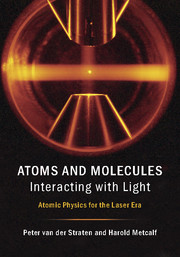Book contents
- Frontmatter
- Contents
- Preface
- Part I Atom–light interaction
- Part II Internal structure
- 7 The hydrogen atom
- 8 Fine structure
- 9 Effects of the nucleus
- 10 The alkali-metal atoms
- 11 Atoms in magnetic fields
- 12 Atoms in electric fields
- 13 Rydberg atoms
- 14 The helium atom
- 15 The periodic system of the elements
- 16 Molecules
- 17 Binding in the hydrogen molecule
- 18 Ultra-cold chemistry
- Part III Applications
- Part IV Appendix
- References
- Index
16 - Molecules
from Part II - Internal structure
Published online by Cambridge University Press: 05 February 2016
- Frontmatter
- Contents
- Preface
- Part I Atom–light interaction
- Part II Internal structure
- 7 The hydrogen atom
- 8 Fine structure
- 9 Effects of the nucleus
- 10 The alkali-metal atoms
- 11 Atoms in magnetic fields
- 12 Atoms in electric fields
- 13 Rydberg atoms
- 14 The helium atom
- 15 The periodic system of the elements
- 16 Molecules
- 17 Binding in the hydrogen molecule
- 18 Ultra-cold chemistry
- Part III Applications
- Part IV Appendix
- References
- Index
Summary
Introduction
Up to here this book has considered in detail only neutral atoms, namely a single nucleus surrounded by its electrons. This chapter will consider molecules, systems with at least two nuclei bound together by their electrons. This change increases the number of possibilities considerably, since all atoms can be combined to form molecules in principle, and the number of atoms in a molecule is unlimited. The study and engineering of molecules forms the heart of chemistry, but this chapter does not intend to give a proper account of this field of science.
Moreover, the discussion here will be restricted to molecules having only two nuclei. The reason is that such diatomic molecules can be described with the techniques that have already been discussed earlier in this book, and therefore they are the atomic physicists’ favorite kind of molecule. Furthermore, the atmosphere of the earth consists of more than 99% diatomic molecules, namely N2 and O2, and the most abundant molecule in the universe is H2. Nevertheless, it is important to remember that polyatomic molecules give us life and reasons to live, even though they will not be discussed here.
The paired nuclei of diatomic molecules provide important additional degrees of freedom. In an atom, the center-of-mass and the nucleus nearly coincide, and in the center-of-mass frame the nucleus is nearly at rest. However, in a molecule the kinetic energy of the nuclei is not negligible since the center of mass is generally well separated from each of them, and the energy of their motion in the center-of-mass frame adds significantly to the total energy of the system.
Since molecules consist of at least three particles, the equations of motion cannot be solved exactly, neither in classical mechanics nor in quantum mechanics. In order to find solutions, one has to resort to approximations. One of the most important of these approximations is enabled by the large difference in mass between the nuclei and the electrons. This results in the nuclei moving much more slowly than the electrons in the center-of-mass frame. It therefore seems natural to treat the nuclei as fixed at a given separation R, calculate the energy of the system, and then repeat the calculations at a different value of R. The result provides a potential V(R) created by the electrons in which the nuclei move.
- Type
- Chapter
- Information
- Atoms and Molecules Interacting with LightAtomic Physics for the Laser Era, pp. 272 - 302Publisher: Cambridge University PressPrint publication year: 2016



